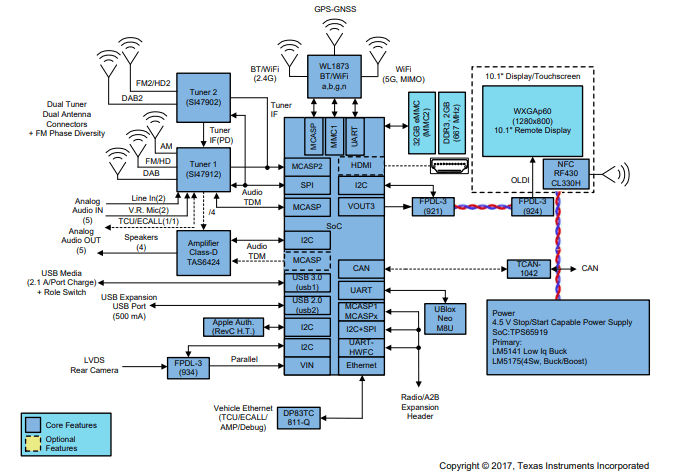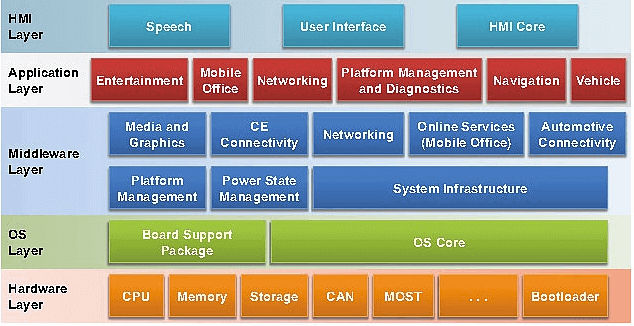Automotive entertainment originally revolved around terrestrial broadcast and local media in the form of CDs and other hard content. Recently, new broadcast mediums such as satellite radio have emerged, enhancing and upgrading audio performance. Now, with integrating amenities such as navigation, service portals and concierge services, the basic radio has evolved into a multifunction information platform—one that links with personal mobile devices and cloud-based service providers. Today’s IVI system is a multitasking platform based on a multicore SoC that performs system application functions such as:
- Multimedia processing, including terrestrial and satellite radio and local media interfaced by hard connection, USB, or Bluetooth
- Embedded navigation including GPS/GNSS/gyro dead reckoning
- Hands-free phone/communications
- I/O control of vehicle functions (climate, preferences, etc.)
- Rear view camera integration and display
- Audio post-processing
- Integration of functional peripherals such as tuners, GPS, display, USB, etc.
- Management of multimodal HMI functionality, including speech, tactile, and display-based interactions
The IVI platform also has a companion MCU that handles low-level vehicle interfaces (CAN/LIN etc.), vehicle tactile controls, power management, booting etc. Packaging is either integrated with the associated display or in a single module deployed next to the display, as interior layout requires, and resides typically in the center of the IP cavity. Key characteristics of the IVI platform include:
- A multicore application processor
- 2-4 cores, generally Arm Cortex® (e.g. A9, A15) 1-1.2 GHz
- GPU
- DSP
- Hardware accelerators for video
- Wi-Fi/Bluetooth peripheral including GPS/GNSS
- Analog and digital terrestrial tuners (AM/FM/DAB/HD/antenna or tuner diversity)
- SDARS receiver including data services
- USB 3.0 interface plus charging and role reversal
- Apple® authentication
- Rear camera interface (typically LVDS or FPD Link)
- Display interface (up to 1080P typically FPD Link or GMSL)
- Touchscreen interface
- Optional HDMI
- Audio peripherals including power amplifiers, extension media bus (e.g. A2B)
- Optional Ethernet
 Figure 1: Typical IVI platform
Figure 1: Typical IVI platform
Typical IVI platform memory requirements are:
- Nonvolatile memory (32-64GB eMMC depending on navigation and speech database)
- DRAM (2-4GB, typically DDR3 – 1066)
- Potential auxiliary SD card for media updates
The software environment is OS-based and abstracted as depicted in Figure 2. Typically, the HMI layer is tool-based.
 Figure 2: IVI software environment
Figure 2: IVI software environment
Today’s basic radio is evolving into a cockpit domain controller, interfacing driver information to clusters, adding heads-up displays with human machine interface (HMI) enhancements such as haptics, gesture recognition, and AI-enhanced speech recognition. In part 3 we will cover the Cockpit Domain Controller